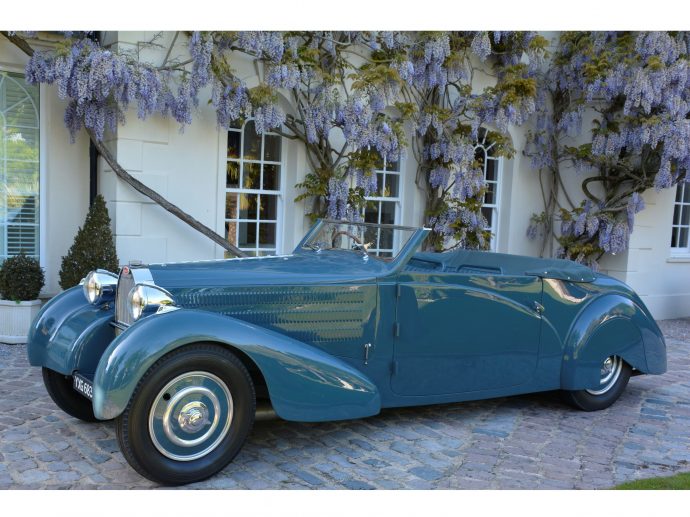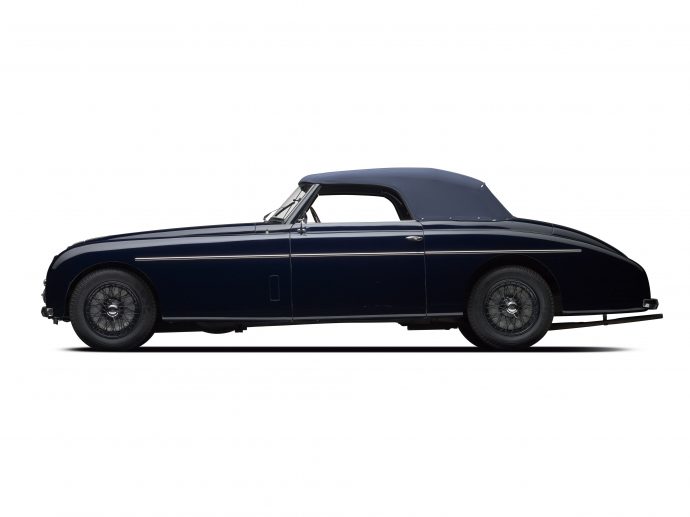Categories more
- Adventures (17)
- Arts / Collectables (15)
- Automotive (37)
- Aviation (11)
- Bath, Body, & Health (77)
- Children (6)
- Cigars / Spirits (32)
- Cuisine (16)
- Design/Architecture (22)
- Electronics (13)
- Entertainment (4)
- Event Planning (5)
- Fashion (46)
- Finance (9)
- Gifts / Misc (6)
- Home Decor (45)
- Jewelry (41)
- Pets (3)
- Philanthropy (1)
- Real Estate (16)
- Services (23)
- Sports / Golf (14)
- Vacation / Travel (60)
- Watches / Pens (15)
- Wines / Vines (24)
- Yachting / Boating (17)
Published
08/13/2023 by Salon PrivéThere is a heavy dose of poignancy attached to these two, rare and beautiful Bugattis which will grace Blenheim’s lawn at this month’s Salon Privé Concours presented by Aviva. Both bodied by Gangloff - the most stylish of Swiss carrozzeria – the pre-war Type 57 typifies the marque’s boom years, being one of the most successful models produced by the Molsheim factory. Whereas the 101 Cabriolet told of a company fighting to sustain its image in the post-war years - though no less glamorous for it.
1934 Bugatti Type 57 Gangloff Stelvio
Salon Privé’s Bugatti T57 illustrates how adaptable the model’s chassis was, having originally been bodied as a saloon, but just three years later transformed into a Stelvio-style open-topped tourer, but with some innovative design revisions by renowned coachbuilder, Gangloff.
Launched in 1934, the Type 57 was one of Bugatti’s most popular models, with a total of 710 produced in a variety of guises up to 1940. Powered by an inline, eight-cylinder engine of 3257cc displacement with twin overhead camshafts and part-spherical combustion chambers, the T57 epitomised Bugatti’s emphasis on advanced engineering. Designed almost entirely by Jean Bugatti, Ettore’s son, the model’s steel chassis was immensely versatile and could underpin anything from a rakish touring body to a four-door saloon.
And chassis number 57143, Salon Privé’s car, was a case in point. Ordered on March 9th, 1934 by Lille agent Créquy et Cornette for customer Maurice Desmuront at a cost of FF 60,800, it was originally delivered to him as a Galibier saloon. After passing through one further owner, Paris Bugatti agent Dominique Lamberjack acquired the car and is believed to have sent it to coachbuilder Gangloff of Colmar to be rebodied. Due to its proximity to the Molsheim factory, Gangloff had effectively become Bugatti’s de facto coachbuilder, so would have been familiar with the style of the factory’s Stelvio body which Lamberjack had asked the company to mirror – but with some important distinctions. These included an ultra-low windscreen, and an Art Deco profile, which, compared with the regular Stelvio body, more effectively concealed the car’s folded hood. However, the car retained much of its original specification, such as a divided front axle, forward-exiting exhaust manifold, and solid mounting of engine to chassis.
In the early 1950s, the car was exported to the United States and passed through a succession of owners. These included, in 1957, Lawrence ‘Lance’ Graf von Haugwitz-Hardenberg-Reventlow, of Beverly Hills, the son of Woolworth heiress Barbara Hutton and the founder of the Scarab Grand Prix racing cars. The car was shown at the Pebble Beach concours in 2003 and exported to Germany three years later, before being imported to the UK in 2014.
1951 Bugatti 101 Gangloff Cabriolet
Salon Privé’s 101 Gangloff Cabriolet is one of only nine such models produced as part of a brave plan by Ettore’s son, Roland, to revive the Bugatti brand in the post-war years.
Based on the pre-war Type 57’s chassis and powertrain, the 101’s prototype was, quite literally, a converted Type 57, with the first two production 101s also being converted from T57s. A further six all-new chassis were then produced, five in 1951 and ’52, and a final chassis in 1965, with a body by Ghia, built for automotive design supremo, Virgil Exner. However, the 101 failed in its task to reignite interest in the Bugatti brand, largely due to the model’s pre-war engineering, at a time when most manufacturers were developing new technologies; there was also a shift towards bringing coachbuilding in-house, marking the gradual decline of external carrozzeria.
Chassis 101501, which will appear at Blenheim this month, was the second of the six new chassis produced, before receiving a two-door, four-passenger cabriolet body by Gangloff. This car is unique, in that it was the only 101 powered by the T57C’s supercharged engine, producing around 200bhp. First sold to Mr. P. Rentz from the Alsace region of France, the car had nine subsequent owners in France, Germany and the US, including the noted American Bugatti collector, Gene Cesari. It was later purchased by the Walter Grell family of Switzerland in 1988, and then acquired by Peter Mullin for the Mullin Automotive Museum in Oxnard, California.
Salon Privé’s David Bagley is delighted to welcome both cars at this month’s concours: “It’s seldom that we see two cars from the same manufacturer that paint such a vivid picture of its rise and decline. But even though the 101 model failed to capture public interest in Bugatti, it is a stunning car, and we’re so glad to have it at Blenheim with its pre-war Type 57 sibling.”
Salon Privé Week 2023
- 30 August – Salon Privé Concours presented by Aviva.
- 31 August – Salon Privé Concours presented by Aviva.
- 1 September – Salon Privé Ladies’ Day presented by Boodles.
- 2 September – Salon Privé Supercar Saturday & Club Trophy presented by Lockton.
- Tickets can be purchased via the website: www.salonpriveconcours.com
Charity Partner
Salon Privé is proud to have The Rainbow Trust Children’s Charity as its charity partner once again. The organisation provides emotional and practical support to families who have a child with a life-threatening or terminal illness, and thanks to the generation donations of guests and Concours entrants, the event has so far raised in excess of £1.1 million for these great causes.
















